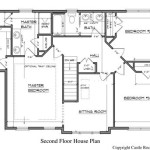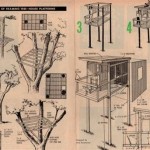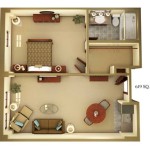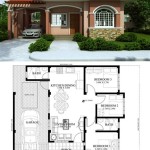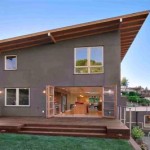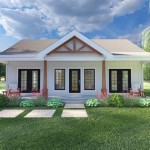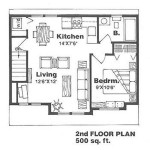Two-Story House Plans with Garage: A Comprehensive Guide
Two-story house plans with garages represent a popular choice for homeowners seeking a balance between space efficiency, storage capacity, and aesthetic appeal. These designs optimize land usage by stacking living areas vertically, creating a larger footprint for living, sleeping, and recreational activities without requiring an expansive lot. The inclusion of a garage, whether attached or detached, provides secure vehicle storage, workshop space, and additional storage options, further enhancing the functionality and value of the property.
The appeal of two-story house plans with garages stems from their versatility in accommodating various lifestyles and needs. These plans are available in a multitude of architectural styles, ranging from traditional to contemporary, allowing homeowners to select a design that complements their personal taste and the character of the surrounding neighborhood. The incorporation of a garage adds practical value, protecting vehicles from the elements and providing a dedicated area for hobbies, DIY projects, and general storage.
This article will explore the various aspects of two-story house plans with garages, covering considerations for choosing the right plan, design elements and architectural styles, and the advantages and disadvantages associated with this type of housing.
Key Considerations When Selecting a Two-Story House Plan with a Garage
Choosing the appropriate two-story house plan with a garage requires careful consideration of several factors to ensure the final result aligns with the homeowner's specific needs, preferences, and budget. These considerations include lot size and orientation, family needs, architectural style, and garage placement.
Lot Size and Orientation: The dimensions and orientation of the building lot play a crucial role in determining the feasibility and suitability of a particular two-story house plan. The plan must comply with local zoning regulations, including setback requirements, height restrictions, and maximum lot coverage. The orientation of the lot can influence the placement of windows and doors to maximize natural light and ventilation while minimizing solar heat gain during the summer months. Furthermore, the slope of the lot can affect the foundation design and the cost of construction. A sloping lot may necessitate additional excavation or the construction of retaining walls, adding to the overall project expense.
Family Needs and Lifestyle: The number of occupants, their ages, and their lifestyle preferences will significantly impact the desired size and layout of the two-story house. Families with young children may prioritize having bedrooms located near the master suite, while families with teenagers may prefer a more segregated bedroom layout for added privacy. The number of bathrooms, the size of the kitchen, and the presence of dedicated living spaces such as a home office or a recreation room should be determined based on the family's daily routines and entertainment habits. The garage size should be proportional to the number of vehicles owned and any anticipated storage requirements for tools, lawn equipment, or recreational gear.
Architectural Style and Aesthetics: Two-story house plans are available in a wide range of architectural styles, each with its unique features and characteristics. Traditional styles, such as Colonial, Victorian, and Craftsman, often feature symmetrical facades, formal layouts, and ornate detailing. Contemporary styles, such as Modern, Minimalist, and Farmhouse, tend to emphasize clean lines, open floor plans, and natural materials. The choice of architectural style should be based on the homeowner's personal taste, the prevailing style of the neighborhood, and the overall aesthetic goals for the project. The design of the garage should complement the architectural style of the house, using similar materials and detailing to create a cohesive and harmonious appearance.
Garage Placement and Accessibility: The placement of the garage relative to the house can affect its accessibility, functionality, and visual impact. Attached garages provide direct access to the house, offering convenience and security, especially during inclement weather. Detached garages offer greater flexibility in terms of placement and size, and they can minimize noise transmission and potential fire hazards. The driveway design should provide ample parking space and easy access to the garage and the house. Consider the placement of the garage doors to minimize visual clutter and maintain the aesthetic appeal of the front facade. Ensure that the garage is compliant with accessibility standards if any occupants require wheelchair access or other mobility aids.
Design Elements and Architectural Styles in Two-Story House Plans with Garages
The architectural style and design elements contribute significantly to the overall aesthetic appeal and functionality of two-story house plans with garages. These elements include roof design, window placement, exterior materials, floor plan layout, and interior finishes.
Roof Design: The roof design is a prominent feature of any house, and it can significantly impact the overall architectural style. Gable roofs, hip roofs, and shed roofs are common choices for two-story houses. Gable roofs are characterized by their triangular shape, while hip roofs have sloping sides and a lower profile. Shed roofs are single-sloped and often used in contemporary designs. The roof pitch, material, and color should be selected to complement the architectural style of the house and to provide adequate protection from the elements. The inclusion of dormers can add natural light and ventilation to the attic space and enhance the aesthetic appeal of the roofline. The garage roof can be designed to match the main house roof or to create a contrasting visual element.
Window Placement: Window placement plays a critical role in maximizing natural light, ventilation, and views. Large windows and strategically placed skylights can brighten interior spaces and reduce the need for artificial lighting. The size and style of windows should be proportional to the size of the room and the overall architectural style of the house. Consider the orientation of the windows to minimize solar heat gain during the summer months and to maximize passive solar heating during the winter months. Bay windows and bow windows can add architectural interest and create additional living space. The garage windows should be designed to provide adequate natural light while maintaining privacy and security.
Exterior Materials: The choice of exterior materials can significantly impact the appearance, durability, and maintenance requirements of the house. Common exterior materials include brick, stone, wood siding, vinyl siding, and stucco. Brick and stone are durable and low-maintenance options that can add a sense of permanence and elegance. Wood siding offers a natural and warm aesthetic but requires regular painting or staining. Vinyl siding is a cost-effective and low-maintenance option that is available in a wide range of colors and styles. Stucco provides a textured and durable finish that is commonly used in Southwestern and Mediterranean-style homes. The exterior materials should be selected to complement the architectural style of the house and to withstand the local climate conditions. The garage exterior should be designed to match the main house exterior, using similar materials and detailing to create a cohesive and harmonious appearance.
Floor Plan Layout: The floor plan layout determines the flow and functionality of the living spaces. Two-story house plans typically feature the main living areas, such as the kitchen, living room, and dining room, on the first floor, and the bedrooms and bathrooms on the second floor. Open floor plans create a sense of spaciousness and encourage social interaction, while traditional floor plans offer more privacy and separation between rooms. Consider the placement of the stairs to minimize noise transmission and to maximize usable space. The garage should be conveniently located near the kitchen or the laundry room to facilitate the transfer of groceries and other items. Ensure that the floor plan complies with accessibility standards if any occupants require wheelchair access or other mobility aids.
Interior Finishes: Interior finishes, such as flooring, wall coverings, cabinetry, and lighting, contribute significantly to the overall ambiance and comfort of the house. Hardwood flooring is a durable and elegant option that can add warmth and character to the living spaces. Tile flooring is a practical and low-maintenance option for bathrooms and kitchens. Carpet is a comfortable and sound-absorbing option for bedrooms and living rooms. The choice of wall coverings, such as paint, wallpaper, or paneling, can significantly impact the look and feel of a room. Cabinetry should be selected to provide adequate storage space and to complement the overall architectural style of the house. Lighting fixtures should be strategically placed to provide adequate illumination and to create a warm and inviting atmosphere. The garage interior can be finished with drywall, paint, and adequate lighting to create a functional and comfortable workspace.
Advantages and Disadvantages of Two-Story House Plans with Garages
Two-story house plans with garages offer several advantages, including efficient land usage, increased living space, and enhanced privacy. However, they also have some disadvantages, such as higher construction costs and potential accessibility challenges.
Advantages:
Efficient Land Usage: Two-story house plans maximize the use of available land by stacking living spaces vertically. This is particularly beneficial for homeowners with smaller lots or in areas where land is expensive. By building upwards, the footprint of the house is reduced, leaving more space for landscaping, outdoor living areas, and other amenities. The inclusion of a garage further enhances the value and functionality of the property without requiring additional land.
Increased Living Space: Two-story house plans typically offer more living space than single-story houses of the same footprint. The additional square footage can be used for bedrooms, bathrooms, living rooms, home offices, or recreation rooms. This is particularly appealing to growing families or homeowners who require ample space for their hobbies and activities. The garage provides additional storage space for vehicles, tools, and other items, further enhancing the overall usability of the property.
Enhanced Privacy: Two-story house plans can offer enhanced privacy compared to single-story houses. The bedrooms are typically located on the second floor, away from the main living areas, providing a more private and quiet retreat. The garage can act as a buffer between the house and the street, reducing noise and visual distractions. The placement of windows and doors can be strategically planned to maximize privacy and to minimize views from neighboring properties.
Disadvantages:
Higher Construction Costs: Two-story houses typically have higher construction costs than single-story houses of the same square footage. This is due to the increased complexity of the structural design, the need for additional framing and support, and the higher costs associated with plumbing and electrical systems. The construction of stairs, which are a necessary feature of two-story houses, also adds to the overall cost. The garage construction, whether attached or detached, contributes further to the building expenses.
Accessibility Challenges: Two-story houses can present accessibility challenges for individuals with mobility limitations. Climbing stairs can be difficult or impossible for people with disabilities, elderly individuals, or those recovering from injuries. The installation of an elevator or a stairlift can improve accessibility, but these options can be expensive. Careful consideration should be given to the placement of essential living areas, such as the master bedroom and bathroom, on the first floor to minimize the need for using the stairs. The garage should be designed with adequate space for wheelchair maneuvering and accessible entry points.
Staircase Safety: Staircases can pose a safety hazard, particularly for young children and elderly individuals. Proper handrails, adequate lighting, and non-slip surfaces are essential to minimize the risk of falls. Consider the placement of child gates at the top and bottom of the stairs to prevent accidents. Regular inspection and maintenance of the staircase are necessary to ensure its structural integrity and safety.

Trendy Two Story House Plans With Garage Drummond

Two Story Four Bedroom House Plan With Garage

Stylish And Smart 2 Story House Plans With Basements Houseplans Blog Com

Amazing 1000 Ideas About Double Y House Plans On Two Story Small Floor

House Plan With 2 Car Garage

12 Simple 2 Bedroom House Plans With Garages Houseplans Blog Com

Source Point House Plan Modern Home Design Two Car Garage

Carlo 4 Bedroom 2 Story House Floor Plan Pinoy Eplans

2 Story House Floor Plans With Measurements Inspiring High Quality Simple 3 Two Modern Garage

Dallas Two Story Modern House Plan With Large Angled Garage Mm 3311

